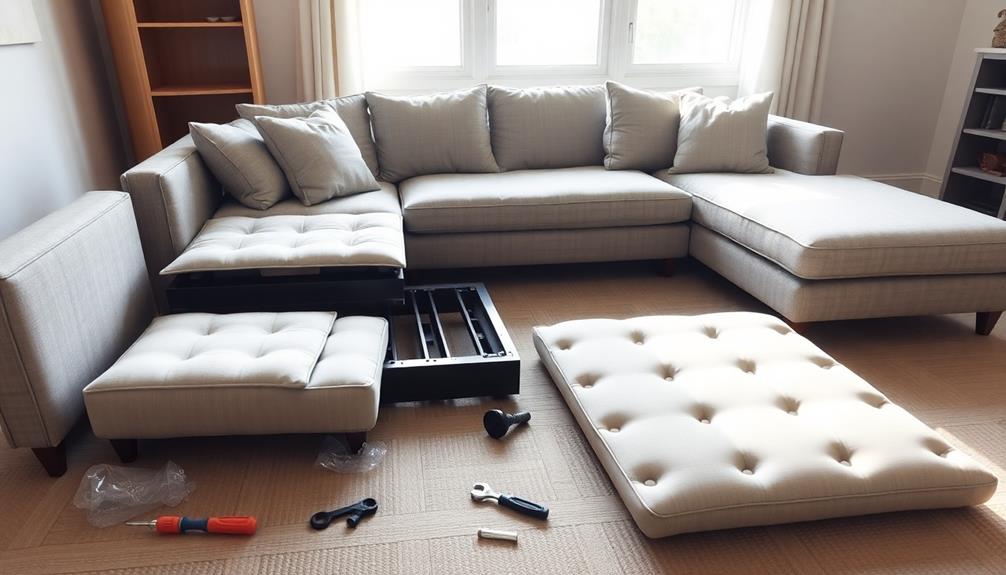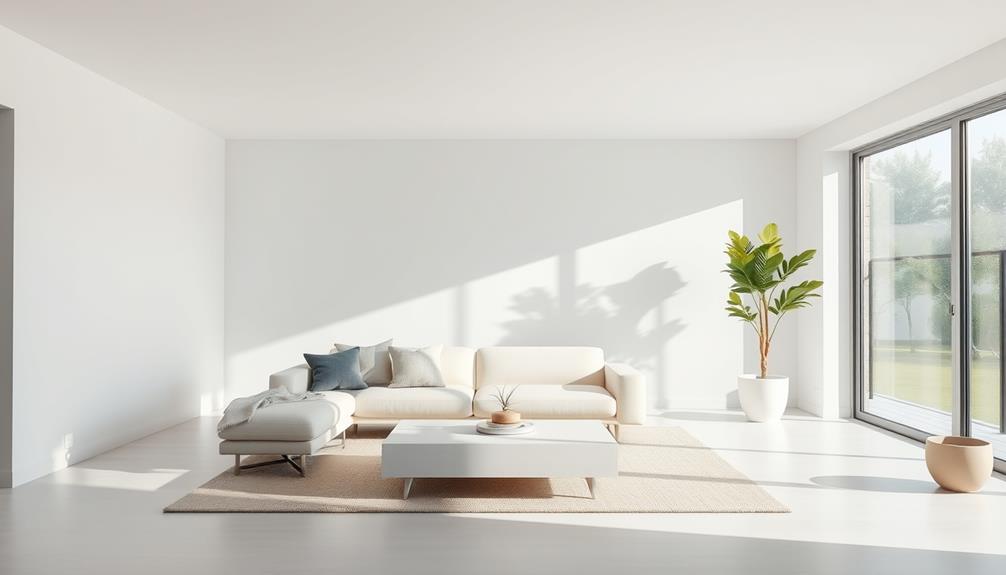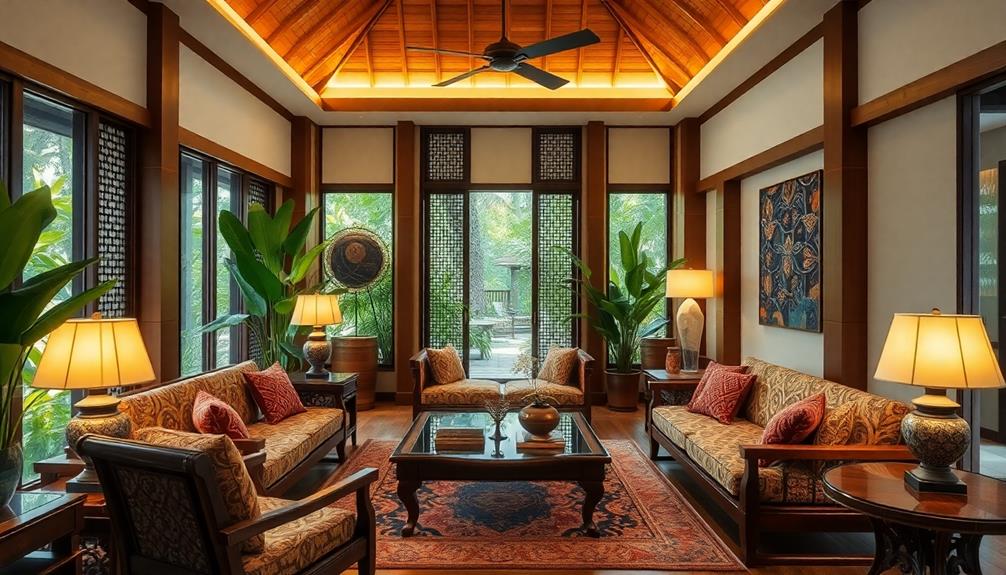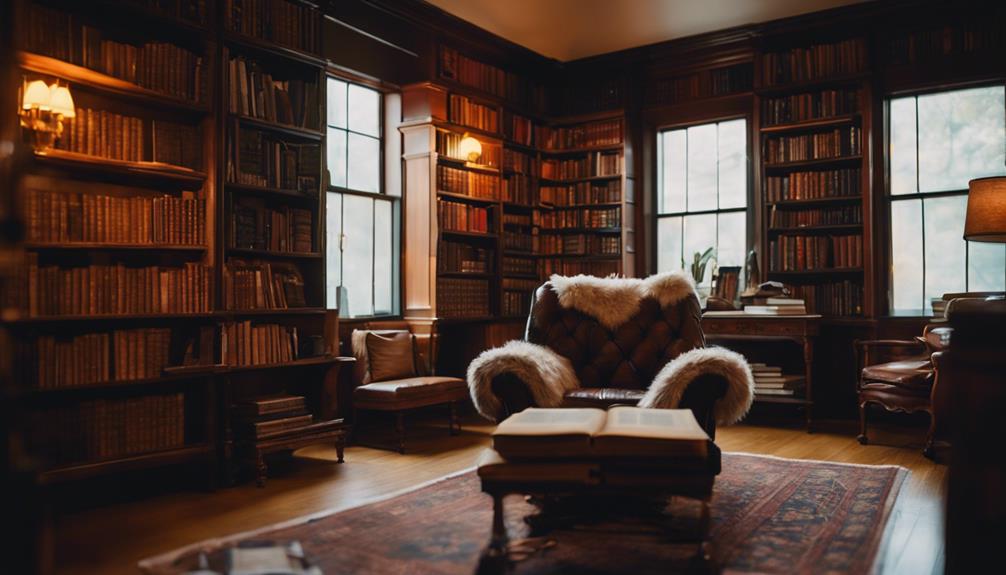To dismantle a sectional sofa, begin by taking out all the cushions and examining for connection points such as pins or latches. Utilize a screwdriver, Allen wrench, and pliers to disconnect the sections. Be mindful of concealed connectors beneath the cushions or in the corners. Keep your work area clear to prevent accidents. Capture the disassembly process with photos to facilitate easier reassembly later on. Exercise caution when dealing with stubborn connections; using lubricant can be beneficial. Always handle heavy sections with care, preferably with the assistance of a friend. If you need advice on safely putting your sofa back together, there is more helpful information coming up to assist you.
Key Takeaways
- Clear the area around the sectional, removing cushions and inspecting for hidden connectors like pins, latches, or brackets.
- Use the appropriate tools, including a screwdriver, Allen wrench, and pliers, to safely detach sections.
- Document the disassembly process with photos for easier reassembly later.
- Employ proper lifting techniques and ask for assistance when handling heavy pieces to prevent injury.
- Ensure all connections are fully disengaged before attempting to separate the sofa sections to avoid damage.
Understanding Sectional Sofa Components
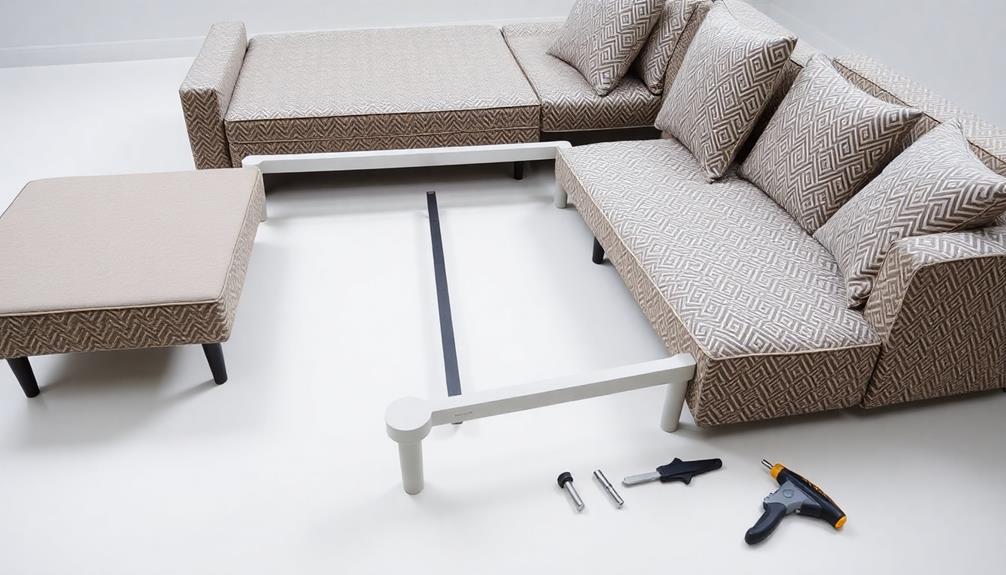
When you're looking to take apart a sectional sofa, understanding its components is important. Sectional sofas typically consist of multiple connected pieces, such as corner sections, loveseats, and chaise lounges. This modular design offers great flexibility in arranging your living space but can complicate disassembly if you aren't familiar with how the sections connect.
For ideal cleaning maintenance, consider using a best vacuum for dust removal to remove any hidden dust and allergens that might accumulate in the crevices of your sofa.
Common connection methods include pins, latches, or brackets. You'll often find a keyhole design for pin attachments, which allows for easy separation. However, the specific design and attachment mechanisms can vary greatly between models. That's why it's important to inspect your sofa thoroughly.
Look for hidden connectors or clasps, which might be tucked away beneath the cushions. These attachment points are essential for safely taking apart a sectional. By identifying all the connection methods, you can minimize the risk of damage during disassembly and guarantee a smoother reassembly process.
Essential Tools for Disassembly
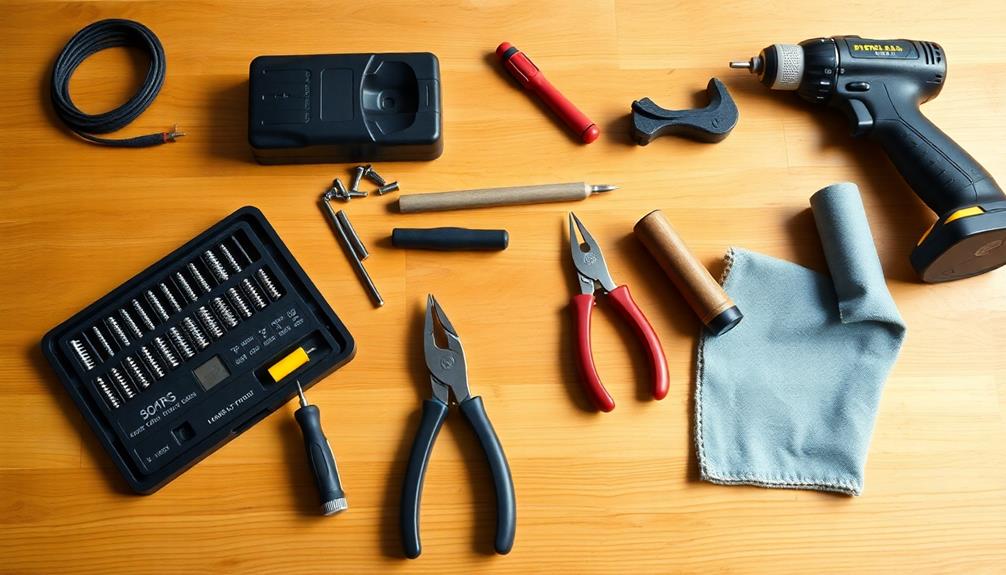
Often, having the right tools makes disassembling a sectional sofa much easier. Here's a list of essential tools you'll need to tackle the job efficiently:
| Tool | Purpose |
|---|---|
| Screwdriver | Removes screws holding sections together |
| Allen Wrench | Loosens bolts for separating parts |
| Pliers | Grips stubborn connections |
| Pry Bar/Crowbar | Helps separate tightly connected sections |
| Flashlight | Illuminates hidden connectors and attachment points |
Before you begin, verify all tools are in good condition and suited for your specific sectional sofa model. You'll also want to have some plastic bags or containers handy to organize small parts and screws as you remove them. This will prevent loss and make reassembly much smoother.
Preparing for the Process
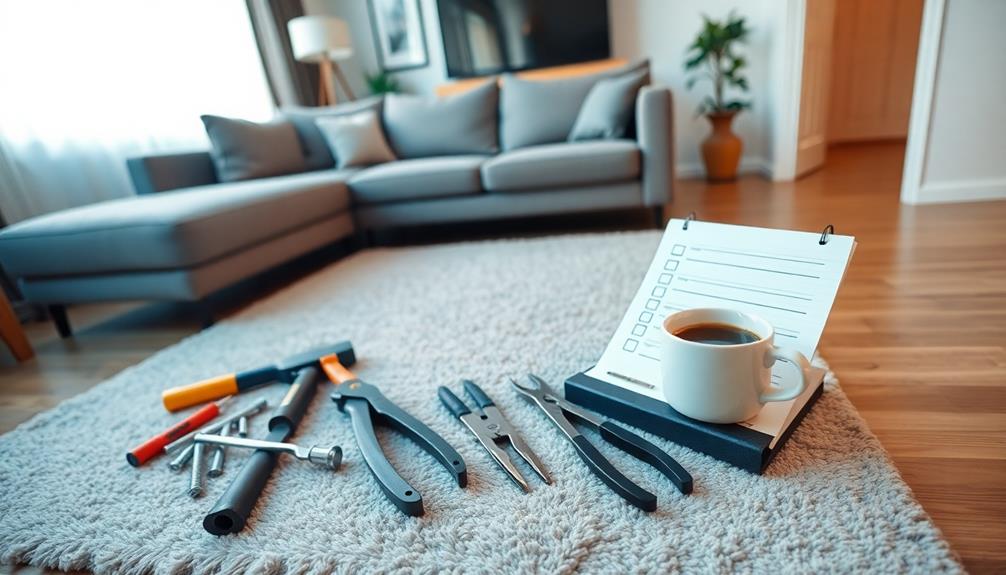
Before you start taking apart your sectional sofa, make certain the area around it's clear of any obstacles. This will help you move the sections easily and safely without risking damage to your furniture or surroundings.
Additionally, consider the importance of maintaining a clean workspace, as it can prevent accidental damage to your sofa and guarantee a smoother disassembly process. Gather the necessary tools, like a screwdriver, pliers, and a flashlight. These will help you inspect hidden connectors and guarantee a smooth disassembly process.
You may also want to familiarize yourself with effective natural ingredients for grout cleaning, as spills can happen during the process.
Remove all cushions and pillows from the sofa to gain access to the connection points. This step prevents obstructions and makes it easier to see how the pieces fit together.
As you disassemble your sectional, consider documenting the process. Take photos of each section and attachment point; these will be invaluable when you're ready to reassemble your sofa later.
Additionally, it's wise to have at least one person assist you during this process. The weight and size of sectional pieces can be cumbersome, and having an extra set of hands will help you manage them safely.
Step-by-Step Disassembly Guide
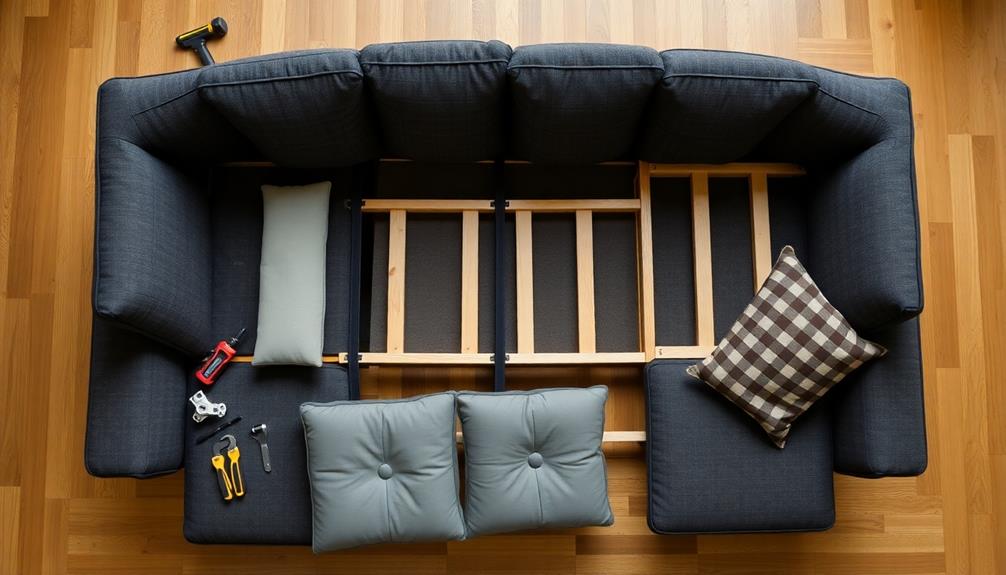
To start the disassembly process, focus on locating the connection points between the sofa sections.
Begin by removing all cushions and inspecting the corners or underside for any pins, latches, or brackets. Use a flashlight to spot hidden attachment mechanisms.
It's also beneficial to contemplate how similar principles apply to appliance maintenance plans when working with complex furniture, as both require careful attention to detail and proper handling to avoid damage.
Follow these steps to take it apart carefully:
- Disconnect Pins or Latches: Gently pull out any pins or flip latches to separate the sections, being cautious not to force them apart to avoid damage.
- Align Keyhole Designs: If your sectional has keyhole connectors, align the section with the keyhole while lifting to remove the pin, ensuring a smooth disconnection.
- Unclip Unique Connectors: For sections featuring alligator clips or other connectors, slide or unclip them carefully to avoid damaging the fabric or frame.
As you disassemble, it's a good idea to document the process. Take photos or label parts to simplify reassembly later on.
Following these steps will help you take apart your sectional efficiently while preserving its integrity.
Common Attachment Methods
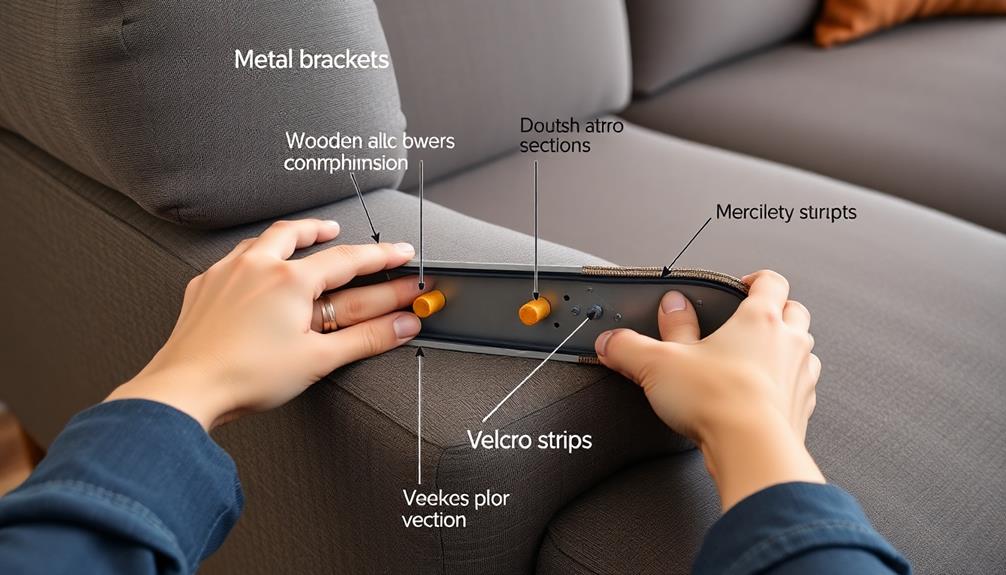
Understanding the common attachment methods used in sectional sofas is essential for a smooth disassembly process. Sectional couches typically employ a few reliable attachment methods to keep their sections securely connected.
You'll often find pins, latches, and brackets as the primary means of attachment. For instance, some sofas might feature DIY Fire Pit Ideas that can inspire creative outdoor designs, demonstrating how various attachment methods can be effectively utilized.
Pin attachments usually feature a keyhole design, which allows you to pull out the pin and lift the section for disassembly. If your sectional has latch mechanisms, they might resemble garden gate latches; you'll need to flip or slide them to release the sections.
Don't forget to check underneath the couch, as some models may hide clasps or screws that can complicate the process. Inspecting these areas is vital to guarantee you identify all potential connection points.
Troubleshooting Common Issues
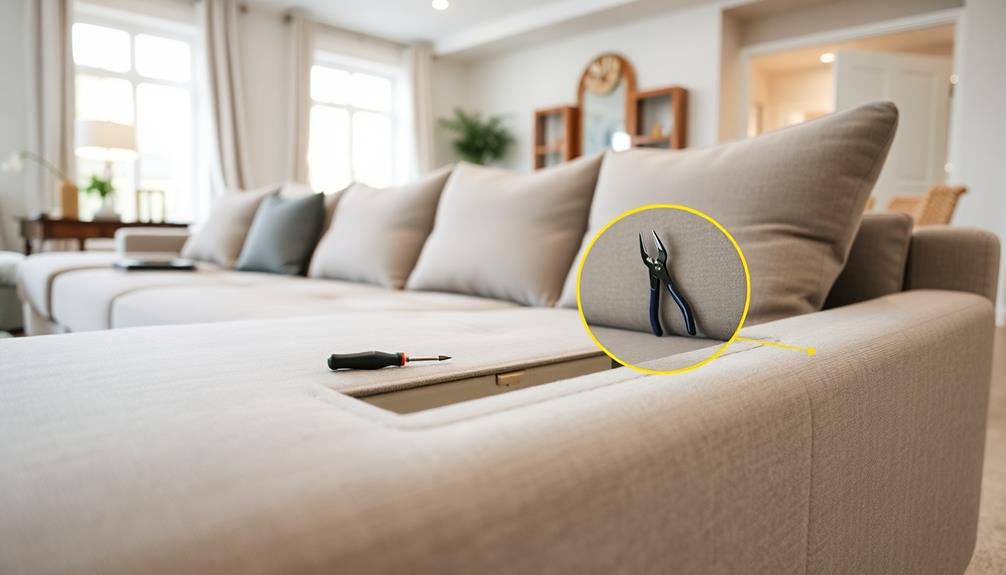
Disassembling a sectional sofa can sometimes lead to unexpected challenges, but troubleshooting common issues can make the process smoother. Here are some tips to help you take apart your sofa without a hitch:
1. Hidden Attachments: Use a flashlight to inspect under the couch for any pins, latches, or brackets that mightn't be immediately visible. Sometimes, these hidden attachment points can be tricky to spot, similar to understanding the nuances of a budget plan for managing your finances.
2. Misalignment Fixes: If you notice that pins aren't aligning with keyholes, gently lift and adjust the section. Ensuring proper alignment before attempting to detach it can save you a lot of frustration.
Just as in investing, where evaluating your risk tolerance can lead to better decisions, being mindful of alignment can prevent unnecessary complications.
3. Stuck Sections: For sections that feel stuck, check for overlooked clasps or connections that might still be securing the pieces together. If a pin is stuck and won't pull out, try applying a small amount of lubricant or gently wiggling it free instead of forcing it.
Safety Precautions to Consider
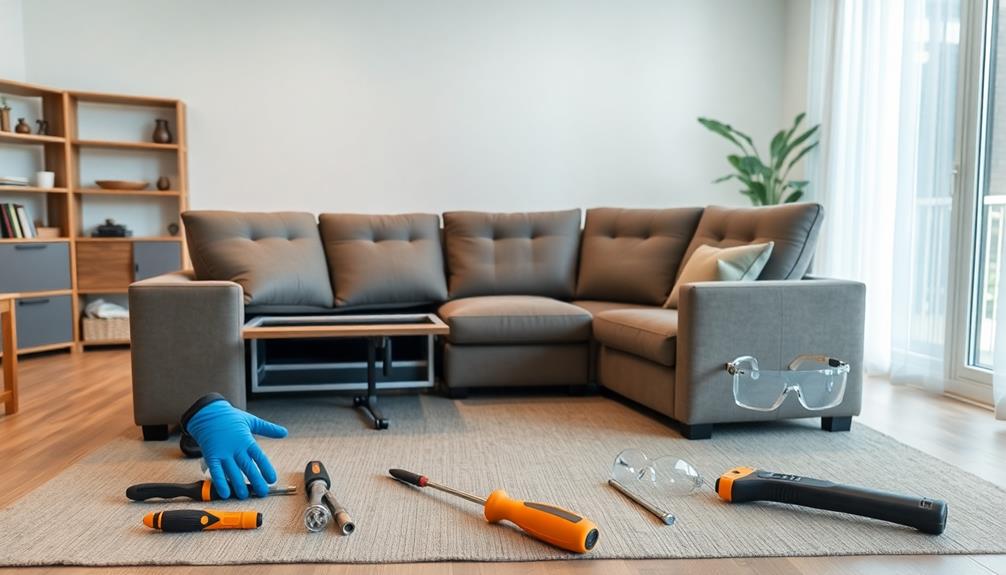
Before you start taking apart your sectional sofa, make certain the area is clear of any obstacles to prevent tripping hazards.
Additionally, consider air purifier maintenance dos and don'ts to guarantee a clean environment while you work.
Don't forget to wear protective gear like gloves and safety glasses, and enlist a friend to help with the heavy lifting.
These precautions will keep you safe and make the process smoother.
Clear Workspace Requirements
Creating a clear workspace is vital for safely taking apart a sectional sofa. You'll want to make certain you have enough room to maneuver around the heavy pieces without any hazards. Here are some key steps to achieve a clear space:
1. Remove all cushions and items: Clear off any cushions or belongings from the sofa. This reduces clutter and gives you unobstructed access to connectors and attachment points.
Consider also checking for any potential side effects related to your physical strains while disassembling the sofa.
2. Allow ample space: Make sure there are at least 2 to 3 feet of clear space around the sectional. This extra room will facilitate easy movement during disassembly and help prevent accidents.
3. Inspect with a flashlight: Before you start, use a flashlight to check for hidden pins or latches. Making certain all connection points are visible and accessible is vital for a smooth disassembly process.
Also, don't forget to disconnect any power cords from power furniture to avoid electrical hazards.
Having at least one other person assist you'll make managing the weight of the sectional much safer. Remember, you need to take apart the sofa with care to prevent injury.
Protective Gear Recommendations
When tackling the task of taking apart a sectional sofa, wearing the right protective gear is vital for your safety. Start by donning safety glasses to shield your eyes from dust, debris, and sharp edges that might be exposed during disassembly. This simple step can prevent potential injuries and keep you focused on the task at hand.
Additionally, it's important to be aware of the surrounding environment, as certain fundamental oils like eucalyptus oil can help maintain respiratory health if you're working in a dusty area.
Next, put on gloves to protect your hands and improve your grip while handling heavy or awkward sections. Gloves can reduce the risk of slips and cuts, especially when you're working alone as one person. If you're sensitive to dust or allergens, consider wearing a dust mask, as disassembling upholstery can release particles into the air.
Don't forget about your feet—steel-toed boots offer essential protection against injuries from dropped furniture pieces. They give you peace of mind while you lift and maneuver heavy sections.
Lastly, make sure that all your protective gear fits properly and feels comfortable. This will encourage you to wear it consistently, enhancing your safety throughout the disassembly process.
Prioritizing these protective measures allows you to tackle the job with confidence.
Assistance for Heavy Lifting
Taking apart a sectional sofa can be physically demanding, so it's crucial to have assistance for heavy lifting. Always enlist the help of at least one other person when lifting heavy sections to prevent injury and guarantee proper handling.
Additionally, consider employing some primitive weapons for modern survival techniques to craft tools that might aid in disassembly. Here are some safety precautions you should consider:
- Use Proper Lifting Techniques: Bend your knees and keep your back straight. This helps avoid strain during the disassembly process.
- Clear the Area: Remove obstacles to create a safe path for moving heavy sections. This reduces the risk of trips and falls.
- Consider Equipment: Utilize moving straps or a dolly. These tools can make lifting and transporting heavy sectional pieces safer and more manageable.
Also, don't forget to wear appropriate clothing and closed-toe shoes to protect yourself from potential accidents.
Rearranging the Sections
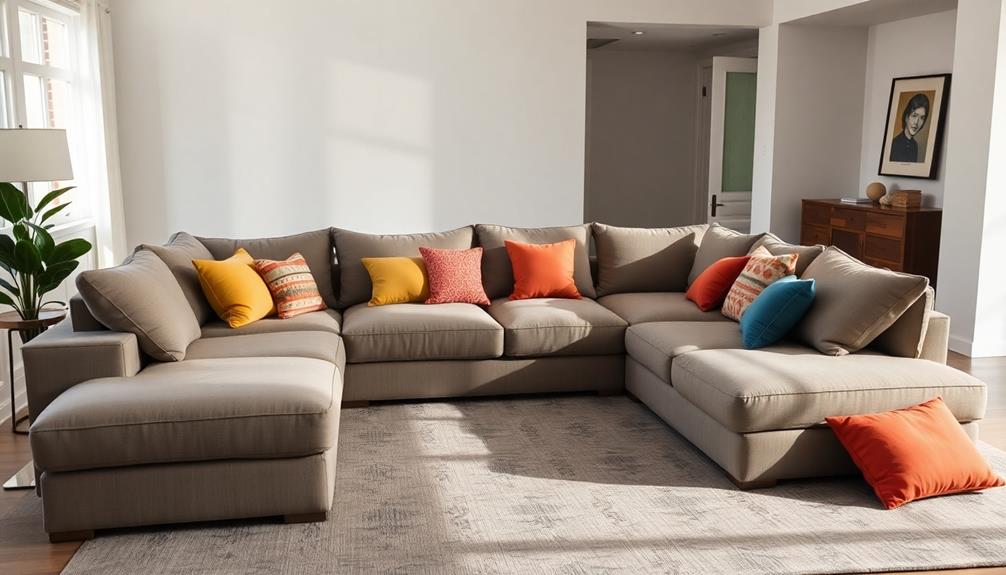
When you're ready to rearrange your sectional sofa, start by evaluating the room layout to guarantee a comfortable flow.
Consider how the arrangement affects your home's overall security and safety, as a well-organized space can deter potential intruders and enhance peace of mind, much like the value of home security systems.
Make certain you align the section connections properly for stability and a polished look.
This thoughtful approach not only enhances the aesthetic appeal but also improves overall functionality.
Assessing Room Layout
Before you plunge into rearranging your sectional sofa, it's crucial to evaluate your room layout carefully. Start by measuring the available space to guarantee each section fits comfortably without blocking pathways or doorways.
Consider how you want to use the room, as the layout can greatly impact social interaction and comfort.
Here are three key factors to think about:
- Functionality: Determine the primary use of the space. Do you want a cozy movie night atmosphere or a social gathering spot?
- Configuration: Sectionals can be arranged in various shapes—L-shapes, U-shapes, or even as separate pieces. Choose a layout that suits your needs.
- Practical Considerations: Keep electrical outlets and natural light in mind. These elements can affect both the comfort and aesthetics of your rearranged area.
Utilizing visual aids like floor plans or room layout apps can help you experiment with different configurations before you physically separate a sectional sofa.
Aligning Section Connections
Once you've decided on the best layout for your room, it's time to focus on aligning the section connections of your sofa.
Start by verifying that the backs of each piece of furniture are properly lined up to create a secure fit and prevent any gaps. Look for alignment indicators, such as grooves or metal slots, which guide the sections into place for a seamless connection.
If your sectional sofa uses pins or latches, double-check that they fully engage and lock into position after aligning the sections. This step is essential for maintaining stability as you rearrange the sofa.
For sectionals with multiple configurations, consider how the arrangement of the sections can optimize your space while still allowing easy access to connectors.
Once you've aligned everything, gently push or pull the sections together to test their stability.
Make any necessary adjustments before replacing the cushions to confirm everything feels secure and comfortable.
Enhancing Aesthetic Appeal
To enhance the aesthetic appeal of your living space, rearranging the sections of your sectional sofa can make a significant difference. This simple change can create a more open and inviting atmosphere, improving flow and accessibility throughout the room.
Consider these tips for effective interior design:
- Avoid Wall Corners: Position your sofa sections away from the walls to allow light and movement, which enhances the overall brightness of the space.
- Choose Light Colors: Opt for lighter, neutral colors for the sectional. This choice makes your room feel larger while you can add colorful cushions or throws for a lively touch.
- Experiment with Configurations: Try different arrangements like L-shapes or U-shapes. This flexibility can help you find the best setup for lounging or socializing.
Tips for Reassembly
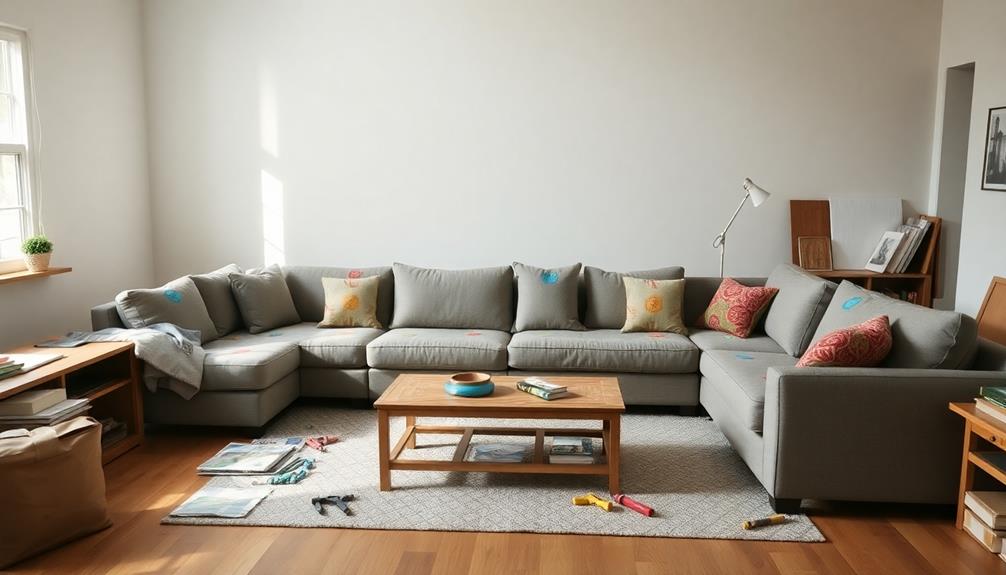
Reassembling your sectional sofa can be a straightforward task if you follow a few fundamental tips. Start by aligning the backs of each piece of the sectional carefully, verifying that the connectors fit together without forcing them. This step is vital to avoid damage and guarantee a snug fit.
Using labeled parts or photos taken during disassembly can greatly ease the reassembly process. These references help you identify where each piece of the sectional belongs, making the task smoother and more efficient.
Don't forget to check for hidden latches or pins that may need to be engaged before fully pushing the sections together. This precaution will help prevent any misalignment.
Once you've successfully reassembled the sofa, make sure all cushions are returned to their respective sections. This not only enhances the aesthetic appeal but also maintains the comfort of the sofa.
Maintaining Your Sectional Sofa
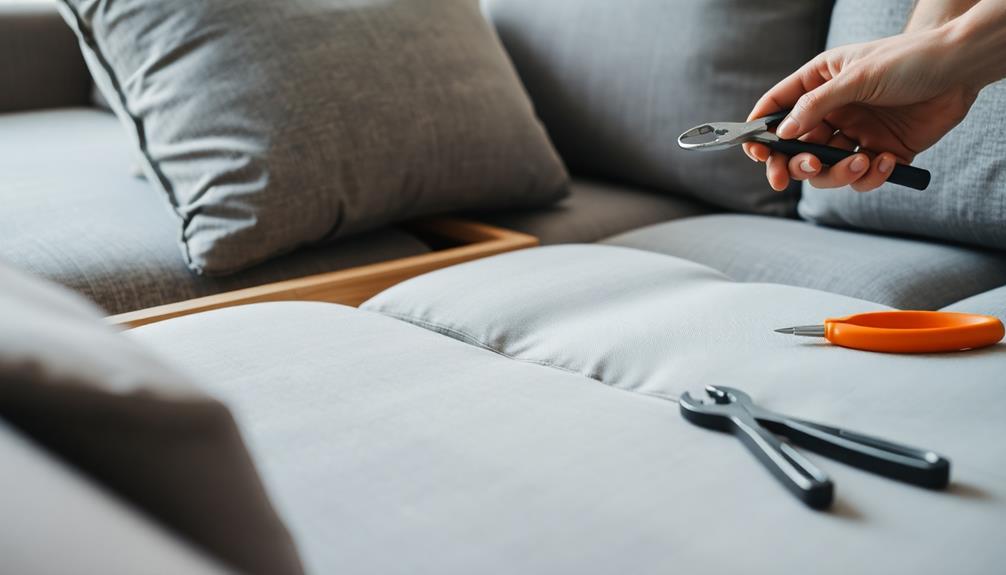
To keep your sectional sofa looking great and functioning well, regular cleaning is a must.
Make it a habit to inspect for any damage, and don't forget to vacuum those hard-to-reach spots.
Regular Cleaning Practices
Maintaining your sectional sofa is essential for keeping it looking its best and extending its lifespan. Regular cleaning practices can make a significant difference in preserving its appearance and comfort. Here are three key steps to follow:
- Vacuum Regularly: Use a brush attachment to vacuum your sectional once a week. This helps remove dust, dirt, and crumbs from both the fabric and crevices, keeping it fresh.
- Spot Clean Stains: For any spills or stains, act quickly! Use a mild detergent and water solution, but always test it on a hidden area first to prevent discoloration.
- Rotate and Fluff Cushions: To maintain the shape of your cushions, rotate and fluff them periodically. This distributes wear evenly across the seating surface and helps them look fuller for longer.
Additionally, schedule a deep cleaning every 6-12 months, either through a professional or with a steam cleaner, to eliminate embedded dirt and allergens.
Protect your sectional by positioning it away from direct sunlight and using fabric protectors to repel spills and stains.
With these practices, you'll enjoy a clean and inviting sectional sofa for years to come!
Inspecting for Damage
After keeping your sectional sofa clean, it's important to regularly inspect it for damage to guarantee its longevity and comfort.
Start by examining the fabric and seams for any signs of wear or fraying. Catching these potential issues early can save you from larger problems later on.
Next, check for loose screws or bolts in the frame. These can compromise the stability of your sofa over time, leading to unwanted movement or even collapse.
Don't forget to assess the cushions; look for sagging or loss of firmness, which may signal that replacement or reupholstering is needed.
While you're at it, pay attention to any unusual creaking or noise when using the sofa. This could indicate underlying structural damage or loose connections that need attention.
Frequently Asked Questions
Can a Sectional Couch Be Disassembled?
Yes, you can disassemble a sectional couch. Look for connectors like pins or latches underneath. Start by removing cushions and carefully detach the sections. It's best to have someone help you with this process.
How to Take Apart a Sofa for Moving?
Disassembling a sofa for moving's like solving a puzzle. Start by removing cushions and identifying connectors. Gather your tools, lift carefully, and document the process. Don't forget to get help for heavy sections!
How to Take Apart a Sofa to Fit Through a Door?
To fit your sofa through a door, start by removing cushions, then identify and disconnect any connectors. If needed, detach legs or armrests. Enlist help to lift and maneuver the pieces carefully. When moving large furniture, it’s important to take your time and communicate with your helpers to ensure everyone is on the same page. Use proper lifting techniques and consider using furniture sliders or a dolly to make the process easier. Once the sofa is through the door, reassemble any disconnected parts and take the time to reposition and fluff the cushions.
How Are Sectional Sofas Attached?
Sectional sofas are like puzzle masterpieces, using pins, latches, or brackets to connect. You'll often find hidden clips or hooks that require a little detective work to uncover. Always check the manufacturer's guidance for specifics!
Conclusion
Taking apart your sectional sofa doesn't have to be a challenging task; it's more like a puzzle waiting to be solved. By understanding its components and using the right tools, you'll breeze through the process. Remember to take your time and keep safety in mind, ensuring each piece is handled with care. Once you've finished, you'll not only have a well-disassembled sofa but also the confidence to tackle future furniture challenges with ease.
